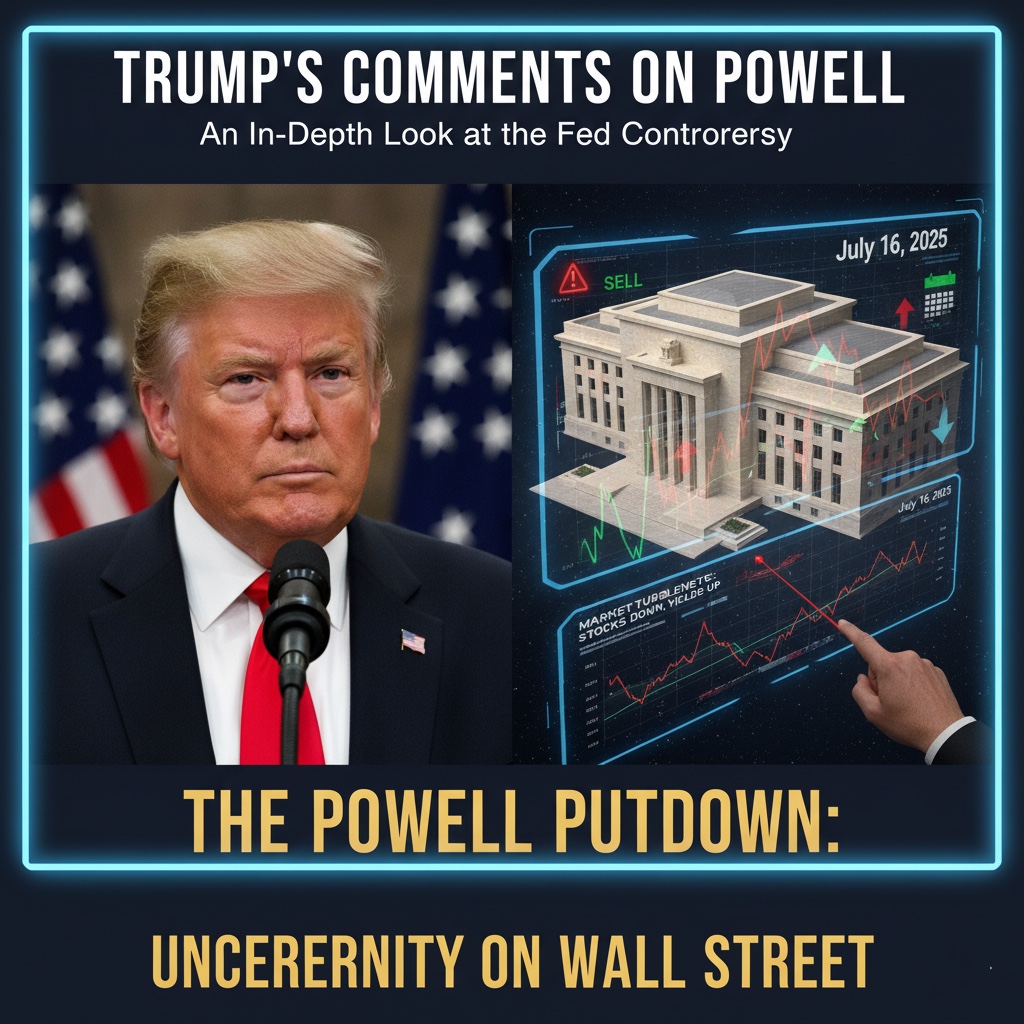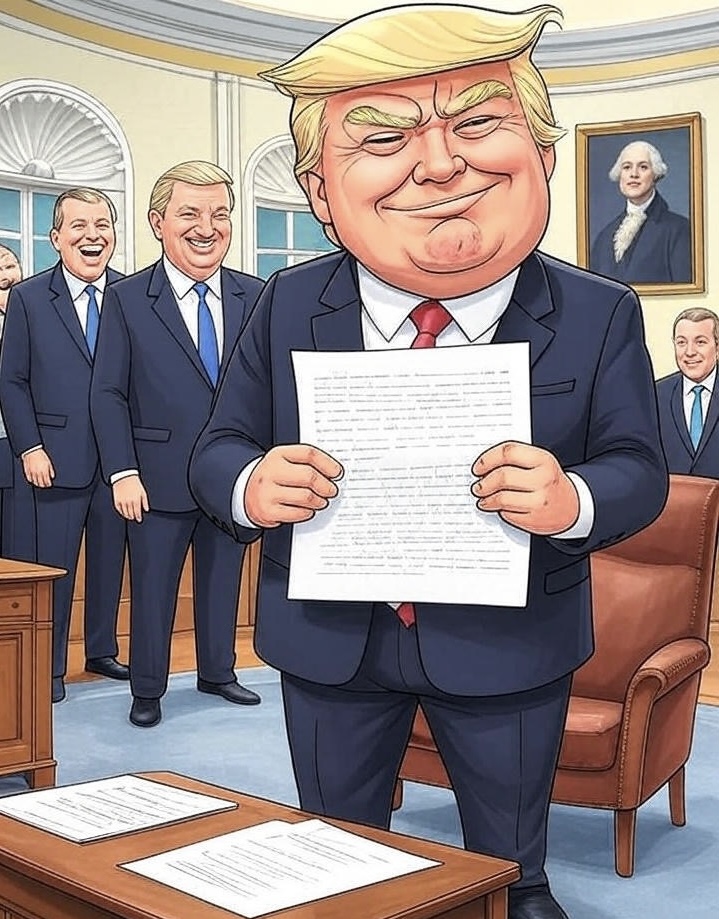
Trump’s Push to Fire Fed Chair Powell: A High-Stakes Gamble
Trump’s Recent Comments on Firing Federal Reserve Chair Jerome Powell: An In-Depth Look

Introduction
Over the past two days, President Donald Trump has sparked renewed debate about his relationship with Federal Reserve Chair Jerome Powell, whom he nominated in 2017 but has often criticized. On July 15, 2025, Trump reportedly discussed firing Powell during a meeting with House Republicans, even presenting a draft dismissal letter. However, on July 16, he publicly stated that such a move was “highly unlikely.” This blog examines these developments, their legal and economic implications, and the broader context of Trump’s ongoing tension with the Federal Reserve.
The Oval Office Meeting: July 15, 2025
On the evening of July 15, 2025, President Trump met with roughly a dozen House Republicans in the Oval Office. According to The New York Times and CBS News, Trump raised the idea of firing Jerome Powell, showing lawmakers a draft letter prepared by William J. Pulte, director of the Federal Housing Finance Agency, outlining Powell’s dismissal. Trump reportedly polled the room on whether to proceed, with sources indicating he received support from several attendees and suggested he “likely would” move forward. The discussion followed Republican opposition to a procedural vote on cryptocurrency legislation Trump supported, hinting that the firing talk may have been partly a response to political frustrations.
On X, Florida Representative Anna Paulina Luna, who opposed the crypto vote, posted, “Hearing Jerome Powell is getting fired! From a very serious source,” later adding, “I’m 99% sure firing is imminent.” These posts reflect sentiment among some Trump supporters but lack independent verification and should be treated with caution.
Trump’s Public Reversal: July 16, 2025
On July 16, 2025, Trump addressed reporters at the White House, downplaying the likelihood of firing Powell. He confirmed discussing the “concept” with lawmakers but stated, “We’re not planning on doing it. I don’t rule out anything, but I think it’s highly unlikely, unless he has to leave for fraud.” This followed market turbulence triggered by the July 15 reports, with the U.S. dollar dropping 0.9%, stocks declining, and Treasury yields rising. Trump’s clarification helped stabilize markets, with stocks recovering by the day’s end.
In an interview with Real America’s Voice, Trump elaborated, saying that firing Powell would “disrupt the market” and expressing hope that Powell might resign voluntarily: “I’d love it if he wants to resign, that would be up to him.” He criticized Powell as a “knucklehead” and “terrible” for not cutting interest rates aggressively. Some X posts, such as one from @NCCoastfan2, claimed Trump told journalist John Solomon he would avoid firing Powell to protect markets, but these claims are unverified and tied to unrelated discussions about the Jeffrey Epstein case.
Why the Tension? Interest Rates and Fed Independence
Trump’s frustration with Powell centers on the Federal Reserve’s monetary policy, particularly its decision to maintain the benchmark interest rate between 4.25% and 4.5% since December 2024. Trump argues that lower rates would offset the economic impact of his trade policies, including 145% tariffs on China, and stimulate growth. However, Powell has cited these tariffs as a reason for caution, warning they could drive inflation, which rose slightly in June 2025, complicating the Fed’s dual mandate of maximizing employment and targeting 2% inflation.
The Federal Reserve’s independence is critical to its ability to make decisions based on economic data rather than political pressure. Powell has defended this autonomy, stating that presidents cannot fire the Fed chair over policy disagreements. A May 2025 Supreme Court ruling supported this, describing the Fed as a “uniquely structured, quasi-private” institution, distinct from other agencies where Trump has removed officials. The ruling indicates that firing Powell would require a “for cause” justification, such as misconduct, not policy disputes.
The Renovation Controversy: A Possible Pretext
A focal point of criticism is the 1.9 billion. On July 10, 2025, Russell Vought, director of the Office of Management and Budget, sent a letter to Powell accusing him of mismanaging the project and potentially misleading Congress during June 25, 2025, testimony. Vought highlighted alleged extravagant features, like a VIP dining room and rooftop beehives. Powell refuted these claims, attributing cost overruns to issues like asbestos removal, and requested an inspector general review. The Fed updated its website to clarify the project’s scope, denying Vought’s allegations.
Analysts, such as Karen Petrou of Federal Financial Analytics, suggest the administration is using the renovation to build a “for cause” case for Powell’s removal. The administration’s replacement of three National Capital Planning Commission members with Trump loyalists further indicates an effort to pressure the Fed. However, legal experts argue that such a move would face significant legal challenges, given the Supreme Court’s stance and Powell’s ability to contest any dismissal in court.
Market and Expert Reactions
The possibility of firing Powell unsettled financial markets. On July 15, reports of Trump’s intentions caused a 0.9% drop in the dollar and declines in U.S. stocks, though markets stabilized after his July 16 comments. Analysts like Tobin Marcus and Chutong Zhu of Wolfe Research warned that removing Powell could lead to an “equity selloff” and a “counterproductive spike in long-term yields.” Former Fed Vice Chair Alan Blinder and former Deputy Treasury Secretary Roger Altman called the idea “dreadful,” emphasizing that undermining the Fed’s independence could fuel inflation and hinder growth. JPMorgan Chase CEO Jamie Dimon stressed the Fed’s autonomy as “absolutely critical” for economic stability.
Legal and Political Ramifications
The Federal Reserve Act of 1913 allows Fed governors, including the chair, to be removed only “for cause,” typically interpreted as serious misconduct. Powell’s term as chair ends on May 15, 2026, and he remains a governor until January 2028. Legal experts assert that firing him over policy disagreements would violate the law, likely sparking a court battle. Powell has stated he would not resign and believes his removal is not legally permissible.
Politically, reactions vary. Senate Majority Leader John Thune and House Financial Services Committee Chair French Hill downplayed the likelihood of firing Powell, while National Economic Council Director Kevin Hassett suggested the administration is exploring its options. Treasury Secretary Scott Bessent mentioned a “formal process” to identify Powell’s replacement, possibly signaling preparations for the end of Powell’s term.
Trump’s History with Powell
Trump’s tensions with Powell date back to his first term, when he criticized 2018 rate hikes but refrained from firing him after advisors warned of legal constraints. In April 2025, Trump denied plans to oust Powell, despite calling him a “major loser” and demanding rate cuts. This pattern of escalation followed by de-escalation suggests Trump uses public pressure to influence the Fed without necessarily acting.
Sentiment on X
X posts from July 16–17 reflect polarized views. Users like @FozonCapital and @fiercefreckled speculated that Trump’s threats were a distraction from other controversies, such as the Jeffrey Epstein files, though these claims lack evidence. Conversely, @moorehn argued that Powell’s policies have harmed household wealth, viewing a potential firing positively. These posts capture public sentiment but are not definitive evidence.
Conclusion
Trump’s recent actions—floating the idea of firing Powell, then calling it “highly unlikely”—reflect a strategy to pressure the Federal Reserve while navigating legal and market constraints. The renovation controversy and tariff disputes highlight efforts to challenge Powell’s leadership, but legal protections and economic risks make an actual firing improbable in the near term. As Powell’s term nears its end in May 2026, attention may shift to his replacement, with figures like Scott Bessent mentioned. This episode underscores the delicate balance between political goals and the Fed’s independence, with significant implications for the U.S. economy.
Disclaimer: This blog is based on information available as of July 17, 2025, from sources like The New York Times, CBS News, and Reuters. X posts are included for sentiment but are not treated as factual unless corroborated. For updates, visit trusted news outlets.